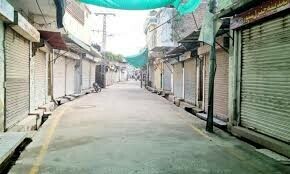
NATIONAL Language Day is a reminder of a bitter truth — deaths cannot bury a cause. Through the decades, Urdu has been dicing with death, and much blood has flowed to sustain it. Impassioned, young have served as consistent catalysts of both social justice and linguistic equality.
One such historic moment rests easy in Karachi’s chaotic Liaquatabad. A lofty board stands in a busy side lane; it bears the slogan of a memorable movement — Urdu ka janaza hai zara dhoom se nikle — a tribute to the Martyrs of Urdu, July 9, 1972.
(It is a funeral of words snatched from our lips, ah doom! Urdu has passed away in pain. Celebrate its death with pomp not gloom)
Opposite, across a congested street, is Masjid Shuhuda-i-Urdu. A small brown gate in the far corner of its mosaic courtyard opens into a small enclave of seven large white graves; their tall, scalloped tombstones resonate with defiance and triumph. The first here is Zahur ul Hasan, age 44, from Jodhpur, Rajasthan; and next to him is Alamgir Shaheed e Khalf Qamaruddin, 32, from Bharatpur — his is the only grave with dashes of aquamarine and two long stemmed roses left by a recent visitor.
In the centre lies Syed Ibrat Mian urf Shakil Mian, a 25-year-old from Rampur with an address in Nazimabad 2. Beside him is Wali Mohammad Bannay, 25, from Dholpur State in a sealed vault, with a residential address in Golimar. There’s Kabirwala, Multan’s Qazi Iqbal Hussain Qureishi, 22, a resident of Liaquatabad, and the eldest martyr is Mohammed Yaqub, 45, a Yusufzai Pathan from Rai Bareilly. As one slides past a barricade towards the last tomb where hangs a new tapestry with the names of Sufi saints Abdul Qadir Shah Gillani, Moinuddin Chishti, Qutub Bakhtiyar Kaki and Baba Farid Gunj Shakar, it’s evident that someone’s pain is still fresh. This is the burial place of this cemetery’s youngest braveheart, a Matric student, Mohammad Zahid, 18, of Rajput descent.
Many other memorials of their comrades are scattered across Sindh, through Hyderabad, Jamshoro, Mirpurkhas to Sukkur. A marble plaque beside the gate is the thread that binds and immortalises each one of them with a synopsis of the upheaval.
It reads: “These are monuments of innocent martyrs of the Urdu Movement in July, 1972, who were killed on the orders of the first chief minister of Sindh, Mumtaz Ali Bhutto. The police opened fire at demonstrations by unarmed men raising the slogan, ‘Urdu ka janaza hai zara dhoom se nikle’.” Patrons of Urdu buried them by the largest intersection of the city in Liaquatabad with the belief that guardians and inheritors of the language will remember their sacrifice. Anjuman-i-Shuhuda-i-Urdu.
“I renovated the graves in 2016 and placed the commemorative tablet. It’s the only graveyard where the name of the assassin is mentioned. The mosque and madressah is ‘qabza’. We wanted a minar, library and an auditorium,” says Dr Saleem Haider, chairman of the Mohajir Ittehad Tehreek.
On July 3, 1972, the Sindh Provincial Assembly passed what proved to be an inflammatory Language Bill whereby Sindhi was declared the official language of the province. Events then took a terrifying turn — the region saw it as a brazen attack on identity through linguistic dominance. By July 7, over 100 were hurt in pro-Urdu marches and strikes. Amid escalating police excesses against students and demonstrators, Karachi, the movement’s epicenter, grew gruesome. Karachi University students set fire to records of the Sindhi Department, KMC market and nearby shops were ablaze, explosive protests multiplied and major cities had to be contained with curfews.
Despite Zulfikar Ali Bhutto’s appeals to end bloodshed, 22 lives were lost in three days, many were critical with 150 wounded. On July 9, some 20,000 people took to the streets as fires swept through Sindh.
An editorial in this newspaper, on July 9, 1972, caught the pulse of the province with clarity: “We would, however, warn against the dangers of political exploitation of the language question…. The way the old Sindhis felt about the dictatorial order against Sindhi during the Martial Law regime is quite understandable. But the rectification of the wrong should not lead to the perpetration of another.”
In short, the sole recourse lay in a neutral zone. President Bhutto, on July 16, 1972 promulgated an ordinance to protect Urdu in ‘accordance with the settlement between Urdu-speaking and Sindhi representatives’.
The roots of this deluge lie precisely two decades prior to it — The East Pakistan Assembly, on February 22, 1952, cleared a resolution which suggested to the Constituent Assembly of Pakistan that Bengali be one of the state languages. This was moved by Provincial Chief Minister Nurul Amin, a day after student remonstrations were met with police bullets. Their initial outcry was to ensure the recognition of their mother tongue as one of the state languages but the cataclysmic episodes that followed were in response to state repression and brutality, which reeked of provincialism.
The region’s repeated entanglement with vernacular supremacy is aptly assessed by Shakil Adilzada, author and literary commentator. “No language can be erased with force but only through livelihood. Any language that provides income will survive. As for Urdu, so many Sindhi scholars wrote in Urdu as did Punjabis, it was never an issue. Only Bhutto’s foolishness to see it as a migrant language.”
History has repeated itself twice over. And two nations, Pakistan and Bangladesh, now celebrate National Mother Language Day on Feb 21 to preserve, respect and nurture their oral legacies. For this reason, universal ideals of cultural and lingual plurality should dominate our discourse. Heritage such as Urdu is not a residue of the1840s; it is a civilisation and an attempt to overpower identity will remain a confrontation with a fierce past.
The writer is a journalist and an author Twitter:@ReemaAbbasi
Published in Dawn, February 23rd, 2020















































